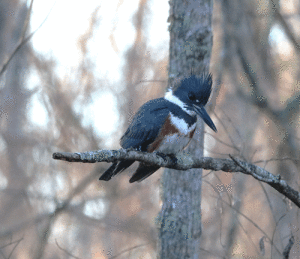
Female Belted Kingfisher observed perched near a small pond during the Brazoria Bottomlands Christmas bird count.
Photo taken on Dec. 30, 2023 by Taylor Bennett.
This time of year marks the start of our beach-nesting bird monitoring season and also spring migration. Gulf Coast Bird Observatory will be monitoring for nesting Wilson’s Plovers and Least Terns within Brazoria County and Matagorda County. Both of these species are protected by the Migratory Bird Act and are considered species of high concern due to habitat loss and disturbance. Along with our beach-nesting birds, we observe other species as well such as the Belted Kingfisher.
Belted Kingfishers are stocky birds that can be seen from Fall to Spring along the Texas Coast. Some even stay here year-round. They prefer to be near any source of water such as creeks, bayous, estuaries, and even backyard fish ponds with a perch close by. We typically see them in Matagorda perched on the telephone wire along the main road next to the wetland habitat.
Belted Kingfishers are easily distinguishable from other bird species. They have a small blue-gray body, a large head with a crest similar to a mohawk, a white collar, a blue-gray belly band, and thick, dagger-like bill.
Usually in the bird world, the male is more colorful than the female. But in the Belted Kingfisher’s case, it’s the opposite. Females have a chestnut belly band that extends to the sides of their body. The males lack the chestnut coloring and just have the blue-gray belly band instead. Immature Belted Kingfishers also appear different than their parents. They instead have a rufous and slate-gray belly band instead of blue-gray belly band. The adults also have a distinct rattle like call which they use to protect their territory.
If you haven’t already guessed by their name, the Belted Kingfisher’s main prey is fish. They mainly feed on small fish such as sticklebacks, mummichogs, and trout. They are only capable of feeding on fish that are small in size. When fish are not abundant, Belted Kingfisher can also feed on crayfish, crabs, insects, frogs, lizards, snakes, young birds, small mammals, and even berries.
Belted Kingfishers mainly hunt by perching on a branch, telephone wire, or pier piling near a body of clear water. When they spot a fish, they swoop down head-first towards the water, eyes closed, and bill slightly open. Their bill acts as a pincher holding on to the fish. They then return to their perch and stun their prey by pounding it against their perch before swallowing it head-first.
The Belted Kingfisher’s stomach chemistry actually changes over time. When they are young, their stomachs are more acidic, and therefore, more capable of dissolving fish bones, scales, and exoskeletons of insects. As they begin to fly, their stomachs become more alkaline and they start to regurgitate pellets instead.
Belted Kingfishers nest in burrows within dirt banks along streams or rivers. During breeding season, both the male and female use their bill to dig the burrow. It can take up to three weeks to complete and ends up being 3 to 6 ft. deep. The female then lays 5-8 eggs and using fish bones, scales, and exoskeletons to insulate the nest.
Belted Kingfisher are common and widespread, so their conservation status is of least concern. They are; however, protected by the Migratory Bird Treaty Act. On behalf of Gulf Coast Bird Observatory thanks for reading.
